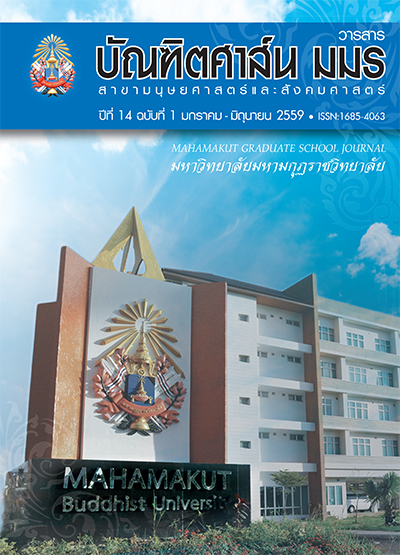ศึกษาหลักไตรลักษณ์ตามลำดับสภาวะของวิปัสสนาญาณ
คำสำคัญ:
ไตรลักษณ์, วิปัสสนาญาณบทคัดย่อ
การศึกษานี้ มีวัตถุประสงค์เพื่อ 1) ศึกษาหลัก ไตรลักษณ์ในคัมภีร์พุทธศาสนาเถรวาท 2) สภาวะ ของวิปัสสนาญาณในการปฏิบัติวิปัสสนาภาวนา 3) หลักไตรลักษณ์ตามลำดับสภาวะของวิปัสสนาญาณ โดยเป็นการวิจัยเชิงคุณภาพภาคเอกสาร จากการศึกษา พบว่า
1. ไตรลักษณ์ เป็นกฎธรรมชาติแห่งความเสมอ กันของสังขารทั้งปวง คือ ไม่เที่ยง เพราะเกิดดับสืบ ต่อกันตลอดเวลา เป็น ทุกข์ เพราะถูกบีบคั้นให้ทนอยู่ ในสภาพเดิมไม่ได้ ไม่ใช่ตัวตน เพราะบังคับให้เป็นไป ตามความปรารถนาไม่ได้
2. วิปัสสนาญาณ คือ ปัญญารู้แจ้ง รูปนามขันธ์ 5 ด้วยการเจริญสติปัฏฐาน 4 กำหนดรู้กาย เวทนา จิต ธรรม จนรู้เห็นรูปนามโดยความเป็นไตรลักษณ์ เพื่อ ละคลายความยึดมั่นถือมั่นในอุปาทานขันธ์ 5 ว่า เป็นตัวตนของเรา
3. สภาวะไตรลักษณ์ เป็นความเสมอกันของสังขาร ทั้งปวง คือ ไม่เทียง เป็นทุกข์ ไม่ใช่ตัวตน ผู้เจริญสติปฏัฐาน 4 มีสติสัมปชัญญะ กำหนดรู้รูปนามโดยความ เป็นไตรลักษณ์ ย่อมเกิดวิปสสนาญาณ 3 คือ 1. นาม รูปปริจเฉทญาณ รู้เห็นรูปนาม 2. ปจั จยปริคคหญาณ รู้เหตุปจั จัยของรูปนาม 3. สัมมสนญาณ รู้เห็นรูปนาม โดยความเป็นไตรลักษณ์ ทำให้ละคลายความยึดมั่น ถือมั่นในอุปาทานขันธ์ 5 และละวิปลาสธรรม ส่งผล ให้ผู้ปฏิบัติ มีความเจริญก้าวหน้าในวิปัสสนาญาณ นำไปสู่ความดับทุกข์
เอกสารอ้างอิง
มหามกุฏราชวิทยาลัย. (2556). พระไตรปิฎกพร้อมอรรถกถา แปล ชุด 91 เล่ม. กรุงเทพมหานคร: โรงพิมพ์มหามกุฏราชวิทยาลัย.
พระพุทธโฆสเถระ. (2554). คัมภีร์วิสุทธิมรรค. สมเด็จพระพุฒาจารย์ (อาจ อาสภมหาเถระ) แปลและเรียบเรียง.กรุงเทพมหานคร: บริษัท ธนาเพรส จำกัด.
พระพรหมคุณาภรณ์ (ป.อ. ปยุตฺโต). (2555). พุทธธรรม ฉบับปรับขยาย. พิมพ์ครั้งที่ 35. สำนักพิมพ์ผลิธัมม์ ในเครือบริษัท สำนักพิมพ์เพ็ทแอนด์โฮม จำกัด.
พระโสภณมหาเถระ (มหาสีสยาดอ). (2554). วิปัสสนานัย เล่ม 2. พระคันธสาราภิวงศ์ แปลและเรียบ เรียง. พระพรหมโมลี (สมศักดิ์ อุปสโม) ตรวจชำระ. กรุงเทพมหานคร: หจก. ประยูรสาส์นไทย การพิมพ์.
สมเด็จพระพุทธชินวงศ์ (สมศักดิ์ อุปสมมหาเถระ). (2554). อริยวังสปฏิปทา ปฏิปทาอันเป็นวงศ์ แห่งพระอริยเจ้า.กรุงเทพมหานคร: หจก. ประยูรสาส์นไทย การพิมพ์.
ดาวน์โหลด
เผยแพร่แล้ว
รูปแบบการอ้างอิง
ฉบับ
ประเภทบทความ
สัญญาอนุญาต
บทความวิชาการและบทความวิจัยในวารสารฉบับนี้ถือเป็นความรับผิดชอบของผู้เขียนเท่านั้น บทความที่ได้รับการตีพิมพ์ในวารสารบัณฑิตศาส์น ถือเป็นลิขสิทธิ์ของมหาวิทยาลัยมหามกุฏราชวิทยาลัย ตามพระราชบัญญัติลิขสิทธิ์



